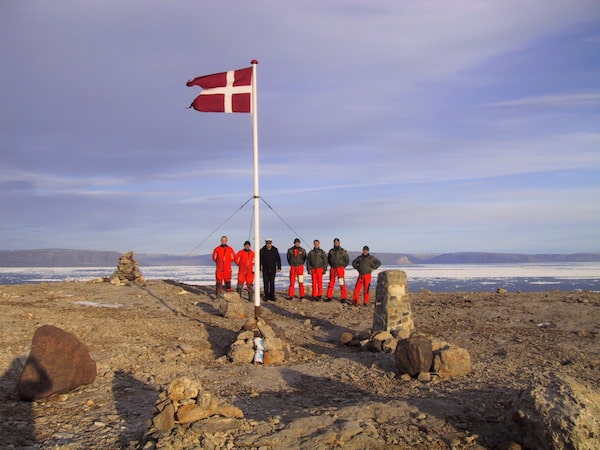
The crew of Danish warship Vedderen perform a flag-raising ceremony on the uninhabited Hans Island off northwestern Greenland, on Aug. 13, 2002.VEDDEREN/The Canadian Press
Canada and Denmark have reached a settlement in a decades-old border dispute over Hans Island, a 1.3-square-kilometre rock in the Arctic sea passage between Greenland and Ellesmere Island, sources say.
The Inuit name for the island is Tartupaluk – describing its kidney-like shape – and under the agreement, a border will be drawn across the island, dividing it between the Canadian territory of Nunavut and the semi-autonomous Danish territory of Greenland.
The Canadians and Danes plan to unveil the settlement June 14 and celebrate it as an example of how countries can resolve border disputes peacefully even as Russia ignored the rules-based international order and launched a full-scale military assault on Ukraine, the sources say. The Globe and Mail is not identifying the sources because they were not authorized to speak publicly on the matter.
The dispute over tiny Hans Island dates back to the early 1970s when the countries were negotiating their maritime boundary; they left the status of the islet for future negotiations.
Aluki Kotierk, president of Nunavut Tunngavik Inc. (NTI), the legal representative of the Inuit of Nunavut on native treaty rights and treaty negotiation, said the dispute has never troubled the Inuit. But she nonetheless hailed the deal.
“The dispute between Canada and Denmark over Tartupaluk or Hans Island has never caused issues for Inuit. Regardless, it is great to see Canada and Denmark taking measures to resolve this boundary dispute,” Ms. Kotierk said in a statement.
“As geographic neighbours with family ties, Inuit in Nunavut and Greenland recognize the significance of working together toward our common future. NTI expects this long-standing relationship between Inuit in Nunavut and Greenland to be a symbol of continued co-operation between Canada and Denmark.”
She also noted the fundamental role that the Inuit play in cementing Canada’s authority over its Arctic territory. “Canada’s sovereignty in the Arctic is only possible because of Inuit use and occupancy,” Ms. Kotierk said.
Michael Byers, an Arctic expert and political scientist at University of British Columbia, applauded news of a deal. He said 2022, when Russia is violating Ukraine’s sovereign territory, is a perfect opportunity for Canada and Denmark to “clean up their own backyard and send a signal to other countries.”
Tussles over Hans Island date back decades.
Back in 1983, Canada issued a land-use permit to a Canadian petroleum company to establish a scientific camp on Hans Island that would study how sea ice might affect drilling rigs, Prof. Byers said. In 1984, Tom Hoyem, then the Danish minister for Greenland, flew to Hans Island by helicopter and planted a Danish flag, prompting the Canadian government to issue a diplomatic protest, he added.
Additional Danish flag plants – and Canadian protests – followed in 1988, 1995, 2002, 2003 and 2004, Prof. Byers said. In 2000, a team of geologists from the Geographical Society of Canada visited the island, mapped its location and took geological samples.
In 2004, the Wall Street Journal quoted Peter Taksoe-Jensen, legal adviser to the Danish foreign minister about how both countries maintained a sense of humour throughout the dispute: “When Danish military go there, they leave a bottle of schnapps. And when [Canadian] military forces come there, they leave a bottle of Canadian Club [whisky] and a sign saying, ‘Welcome to Canada.’ ”
In 2005, then-defence minister Bill Graham visited Hans Island to assert Canada’s claim. His trip came shortly after Canadian military personnel visited the island and planted a Canadian flag and built an Inuit stone marker known as an inukshuk.
Mr. Hoyem, the former Danish minister, responded by writing a column in The Globe where he asserted that, “Hans Island has been used for centuries by Greenlandic Inuit as an ideal vantage point to get an overview of the ice situation and of the hunting prospects, especially for polar bears and seals. The Canadian Inuit have never used the island.”
Prof. Byers said Canadians should remember that the Inuit in Greenland and Nunavut “are the same people and they did not have boundaries and borders prior to Europeans arriving.”
He said he thinks that the fact Prime Minister Justin Trudeau has not made Arctic sovereignty part of his political brand has helped create a situation where a deal could be struck.
“It’s a great example of how when you dial down the political temperature, you can resolve points of friction.”
The settlement means that for Canadians who can afford the many thousands of dollars it would cost to reach this islet, Hans Island offers them a unique Canadian land border with Europe.
“You will be able to go to Hans Island and step from Canada into Europe and back into Canada. I can’t imagine there will be any border official there,” Prof. Byers said.
He said the settlement to his knowledge has no impact on surrounding maritime rights because Canada and Denmark settled those matters in 1973.
Our Morning Update and Evening Update newsletters are written by Globe editors, giving you a concise summary of the day’s most important headlines. Sign up today.